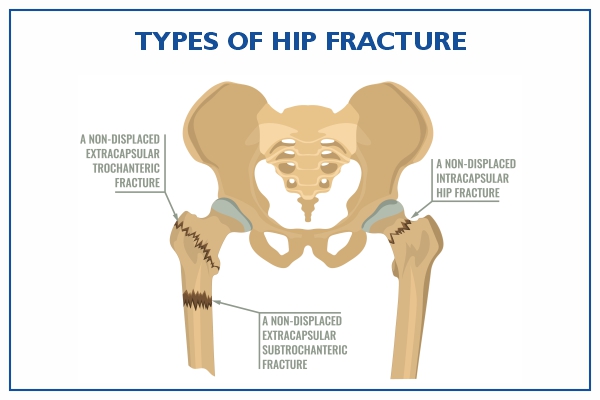
Direct Anterior Hip Replacement Surgery
Direct anterior hip replacement surgery is a minimally invasive surgical technique. This process includes a 3 to 4-inch incision that is made on the front of the hip that allows the joint to be replaced by moving muscles apart along their natural tissue planes without detaching any tendons. This approach frequently results in a faster recovery, less pain, and more normal function following hip replacement. This helps the patients to continue the normal day-to-day activities soon after surgery and there is very little risk of dislocation.
Who Should Go For This Surgery
When the following conditions exist, joint replacement should be considered:
- When arthritis reduces a patient's quality of life.
- Arthritis negatively affects a patient's ability to function normally (for example, putting on shoes/socks, getting out of a chair, and so on).
- When X-rays show moderate-to-severe arthritis.
- Patients are in good enough health to undergo an elective procedure.
- When the advantages of the surgery outweigh the disadvantages of the surgery.
Pain is a significant limitation for the majority of patients with hip arthritis. Some patients with a high pain tolerance may be able to live with pain for many years. The most important factor in deciding whether to have surgery is the patient's quality of life.
Advantages of direct anterior hip approach?
Because the surgeon does not cut through muscle and soft tissue areas, you will typically have less pain and better mobility after the surgery will leave the hospital sooner, will require less pain medication, and will heal well without the need for extensive physical therapy.
According to studies, patients who have the anterior hip approach can walk on their own up to six days sooner than those who have traditional surgery. Here are some advantages-
- Less pain
- Fast recovery
- No blood loss
- High-end implants
- No ICU stay
- To ensure long-term outcomes
- Faster discharge
- Term out-comes

Secure your health with a second opinion. Make informed decisions and book your appointment today!
Get A Second OpinionDuration Of The Surgical Procedure
Direct anterior total hip replacement will take around 1 to 2 hours on average, though preoperative preparation and postoperative recovery can add several hours. Before going to their ward bed, patients may spend 30 minutes to an hour in the recovery room.
The average hospital stay after direct anterior total hip replacement is one day (leave the next day after surgery).
Risks Of Direct Anterior Hip Replacement
A hip replacement is one of the safest and most effective surgical procedures available, but all surgical procedures carry some risk. Hip dislocation is a risk of hip surgery, particularly in the weeks following the procedure. However, because the muscles and soft tissues are preserved and play a role in preventing hip dislocation, you are less likely to dislocate your hip after an anterior hip surgery.
Numbness of the skin in the front of your thigh is a risk of surgery that is unique to the direct anterior hip approach. Stretching of the skin nerves can cause this. It vanishes after some time.
The risks of most hip replacements—and many surgeries—have less to do with the surgical approach and more to do with the patient's overall health. As with any surgery, it's critical to inform your anesthesiologist and surgeon about your age, weight, medications you're taking, and general health, as well as whether you smoke. These factors can affect your risks.
Recovery
Pain and its treatment- Regardless of the surgical approach, any operation causes pain. Although surgical pain is present, most patients after hip replacement believe their "arthritic" pain is gone.
Direct anterior hip replacement patients may experience less pain in the early postoperative period than traditional approaches, but this depends on a variety of factors (e.g., pain level before surgery, pain tolerance, pain medication before surgery, and so on).
Oral pain medication is usually effective at controlling pain. Non-narcotic pain medications (e.g., anti-inflammatories, Tylenol, etc.) will be prioritized because they are effective and have few side effects. Narcotic medication is available.
Medications
Medications are given regularly following surgery. This means that whether a patient complains of pain, a combination of medications (typically an anti-inflammatory, Tylenol, and nerve pain medication) is routinely administered. This enables pain to be "pre-treated." On a patient's request, oral narcotic medications are available for "break-through" pain.
Patients will be discharged with the same medications that were found to keep them comfortable during their stay in the hospital. Pain medication may be required for 2-6 weeks following surgery.
Side effects
Pain medications might cause some reactions or side effects such as-
- Drowsiness
- Problem in breathing
- Difficulties in emptying the bladder and bowel
- Nausea
- Vomiting
- Allergic reactions
Conclusion
Direct anterior hip replacement surgery is a minimally invasive surgical technique. This method uses a 3 to 4-inch incision on the front of the hip to replace the joint by moving muscles apart along their natural tissue planes without detaching any tendons. This approach frequently leads to a faster recovery, less pain, and more normal function following hip replacement. Hip precautions are usually unnecessary because the tendons are not detached from the hip during direct anterior hip replacement. This helps patients to carry out normal daily activities sooner after surgery, with a lower risk of dislocation.
Direct anterior hip replacement is not appropriate for all patients, with the main limitations being body weight (BMI greater than 35) and complex hip disorders (e.g. hip dysplasia, previous surgeries, etc.)
Secure your health with a second opinion. Make informed decisions and book your appointment today!
Book an AppointmentFrequently Asked Questions
A minimally invasive hip replacement surgery that avoids nearby muscles and tendons. For eligible patients who want less pain and a faster recovery time after surgery. The anterior approach, which is more technically demanding, is not used by all hip surgeons.
Because the muscles surrounding the hip joint are not cut during the anterior approach, recovery takes only two to eight weeks.
The majority of post-surgery limitations are based on comfort. After a direct anterior approach, there is usually no need for hip precautions, so motion is not restricted. Patients can return to work when they are ready, which usually takes 2 weeks or more.
For at least six weeks, avoid sleeping on your affected side. After your doctor has given you the all-clear, listen to your body and only lie on your operative side when you are at ease.
Stairs may also be difficult to climb while recovering. Patients with anterior hip replacement can bend their hip freely immediately after surgery and use their hip normally without any restrictions. Before leaving the hospital, they go up and down the stairs under supervision.
